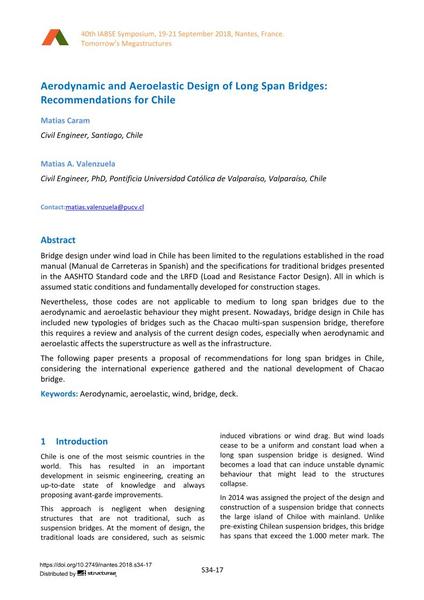Aerodynamic and Aeroelastic Design of Long Span Bridges: Recommendations for Chile

|
|
|||||||||||
Bibliographic Details
| Author(s): |
Matias Caram
(Civil Engineer, Santiago, Chile)
Matías A. Valenzuela (Civil Engineer, PhD, Pontificia Universidad Católica de Valparaíso, Valparaíso, Chile) |
||||
|---|---|---|---|---|---|
| Medium: | conference paper | ||||
| Language(s): | English | ||||
| Conference: | IABSE Symposium: Tomorrow’s Megastructures, Nantes, France, 19-21 September 2018 | ||||
| Published in: | IABSE Symposium Nantes 2018 | ||||
|
|||||
| Page(s): | S34-17 | ||||
| Total no. of pages: | 8 | ||||
| DOI: | 10.2749/nantes.2018.s34-17 | ||||
| Abstract: |
Bridge design under wind load in Chile has been limited to the regulations established in the road manual (Manual de Carreteras in Spanish) and the specifications for traditional bridges presented in the AASHTO Standard code and the LRFD (Load and Resistance Factor Design). All in which is assumed static conditions and fundamentally developed for construction stages. Nevertheless, those codes are not applicable to medium to long span bridges due to the aerodynamic and aeroelastic behaviour they might present. Nowadays, bridge design in Chile has included new typologies of bridges such as the Chacao multi-span suspension bridge, therefore this requires a review and analysis of the current design codes, especially when aerodynamic and aeroelastic affects the superstructure as well as the infrastructure. The following paper presents a proposal of recommendations for long span bridges in Chile, considering the international experience gathered and the national development of Chacao bridge. |
||||
| Keywords: |
wind bridge deck aerodynamic aeroelastic
|
||||
